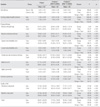Abstract
Purpose
This study was conducted to test the effects of a community health promotion project for farmers cultivating garlic. Bandura's self-efficacy theory (1986) and Chaskin's community capacity framework (2001) were used as the theoretical framework.
Methods
A nonequivalent control group pretest-posttest design was used. Study participants were 72 garlic farmers (intervention: 36, control: 36). The community health promotion project consisted of health promotion program and community capacity building strategies and was provided for 12 weeks (8 during farming off-season and 4 during farming season). Data were collected between February 23 and May 31, 2009 and were analyzed using chi-square test, Fisher's exact test, t-test, and repeated measure ANOVA using SPSS/WIN 12.0.
Results
For the experimental group, significant improvement was found for self-efficacy, farming related health behavior, physical fitness (muscle strength, muscle endurance, upper body flexibility, lower body flexibility, cardiovascular endurance, balance, agility), farmer's syndrome, and health related quality of life as compared to the control group.
Figures and Tables
References
1. Bandura A. Social foundations of thought and action: A social cognitive theory. 1986. Englewood Cliffs, NJ: Prentice Hall.
2. Chaskin RJ, Brown P, Venkatesh S, Vidal A. Building community capacity. 2001. New York: Aldin De Gruyter.
3. Cho BH, Jung MS, Min SH. Health promotion and community capacity. Korean Journal of Public Health. 2007. 44:95–112.
4. Choi SH. The effect of health promotion program on health of the clients with arthritis in primary health care center. Journal of Korean Community Nursing. 2001. 12:344–360.
5. Faul F, Erdfelder E, Lang AG, Buchner A. Statistical power analyses using G*Power 3.1: Tests for correlation and regression analyses. Behavior Research Methods. 2009. 41:1149–1160.
6. Jung YH, Seo YS, Seo NS, Rhe SA, Lee SH. A model building of rural health promotion project connected to health related community resources. 2006. Naju: Dongshin University, Management center for health promotion.
7. Kegler MC, Norton BL, Aronson RE. Strengthening community leadership: Evaluation findings from the California healthy cities and communities program. Health Promotion Practice. 2008. 9:170–179.
8. Kim EJ. Factors influencing the farmers syndrome. Journal of Korean Community Nursing. 2002. 13:817–825.
9. Kim HS, Gu MO. Survey of general & farming related characteristics, health status, farmer's syndrome, farming related health behavior in garlic cultivating farmers. 2008. Unpublished manuscript.
10. Kim HS, Park WY. Senior fitness test manual. 2005. Seoul: Daehanmedia.
11. Kim IS, Kang SJ, Kim KH. The effect of self-help management program by strengthen self-efficacy on self-efficacy and the activities of daily living in stroke patients. Journal of Korean Academy of Adult Nursing. 2008. 20:526–536.
12. Koh SB, Chang SJ, Kang MG, Cha BS, Park JK. Reliability and validity on measurement instrument for health status assessment in occupational workers. Korean Journal of Preventive Medicine. 1997. 30:251–266.
13. Komatsuzaki O. Psychosomatic evaluation of so-called "Nofusho" symptoms. Symposium conducted at the meeting of the 4th International Congress of Rural Medicine. 1970. Tokyo, Japan.
14. Lee KS, Kim KR, Kim HC, Kim KS. Current status and management of agricultural industry accidents for improving quality of life of farmers. 2006. Suwon: Research center of rural resources, Rural development administration.
15. Lim KS. Development and evaluation of health promotion program for vinyl house farmers. 2004. Daegu: Keimyung University;Unpublished doctoral dissertation.
16. Meng KH. A study on the farmer's syndrome in rural residents. Human Science. 1980. 4:45–51.
17. Ministry of Health & Welfare. Community-specific health promotion behaviors project. 2008. Seoul: Author.
18. Oak JS, Park WY. Effects of resistance training on fitness andequilibrium sensory function in old adults. Exercise Science. 2004. 13:101–112.
19. Park JS. A model for health promoting behaviors in late-middle aged women. 1995. Seoul: Seoul National University;Unpublished doctoral dissertation.
20. Park JS. A model for health promoting behaviors in late-middle aged women. 1995. Seoul: Seoul National University;Unpublished doctoral dissertation.
21. Park JS, Oh YJ, Kwon SM. The effects of a tailored health promotion program on self efficacy, health problem and quality of life of rural residents. Journal of Korean Academy of Community Health Nursing. 2007. 18:523–533.
22. Park MK, Kang KS, Kim NY. Effects of a smoking cessation program on amount of smoking and nicotine dependence and self-efficacy of smoking cessation for smoking workers. Journal of Korean Academy of Nursing. 2007. 37:1073–1079.
23. Ware JE, Sherboune CD. The MOS 36-item short-form health survey (SF-36). 1. Conceptual framework and item selection. Medical Care. 1992. 30:473–483.




 PDF
PDF ePub
ePub Citation
Citation Print
Print






 XML Download
XML Download